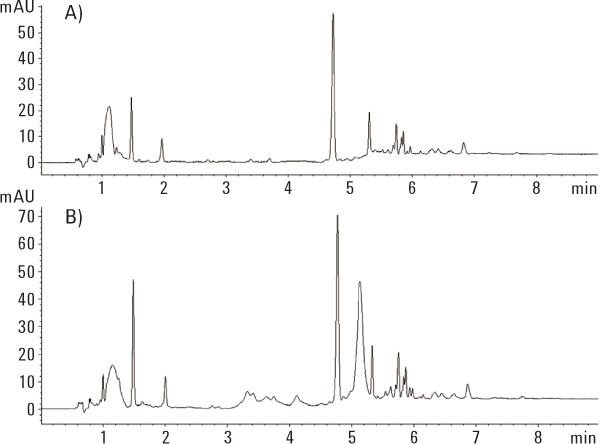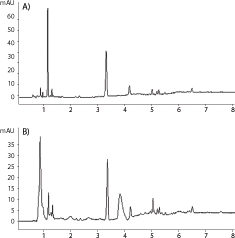Access Agilent eNewsletter, November 2013
>> Update My Profile | Subscribe to Access Agilent | Article Directory
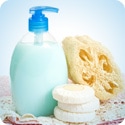
Looking for cleaner samples? Agilent Chem Elut SLE outperforms LLE
By Trisa Robarge
Agilent Product Manager, Sample Prep
One of the main problems associated with liquid-liquid extraction (LLE) is the formation of emulsions during the shaking stage. However, to avoid this emulsion formation, you can use solid-supported LLE (SLE).
In SLE, a high purity, finely divided, inert, diatomaceous earth sorbent is used to help extract the analyte from an aqueous solution into an organic solvent. The aqueous solution containing the analyte passes through a cartridge filled with the sorbent and the aqueous phase is adsorbed onto the diatomaceous earth. After adsorption, an immiscible organic solvent passes through the cartridge to extract and elute the analyte off the diatomaceous earth. Because the aqueous solution is spread over the sorbent in a very thin layer, the two solvents are in intimate contact and the analyte can be extracted into the organic solvent without shaking. This helps to avoid the problem of emulsion formation that is so common in LLE.
In this article we discuss two examples using Agilent Chem Elut cartridges to illustrate the effectiveness of SLE in analyzing parabens and phthalates in body wash by HPLC. Both applications compare SLE to traditional LLE, using methods originally developed for measuring pesticide residues in honey [1].
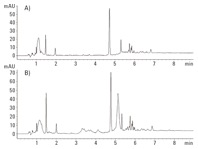 Enlarge
Enlarge
Figure 1. Chromatograms of infant shampoo/body wash (not spiked) after A) SLE and B) LLE for analysis of parabens, showing the cleaner extract provided by Agilent Chem Elut SLE.
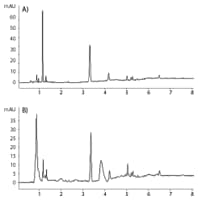 Enlarge
Enlarge
Figure 2. Chromatograms of infant shampoo/body wash (not spiked) after A) SLE and B) LLE. The Agilent Chem Elut SLE extract was much cleaner.
Simple sample prep works for both LLE and SLE
To prepare the body wash sample prior to extraction by either SLE or LLE, take 1.00 ± 0.05 g of sample, spike as necessary, add 2.5 mL acetone, add 1.25 mL 20% NaCl solution, and vortex for 30 seconds.
To extract the analytes using SLE, load the prepared sample onto the SLE cartridge, wait 15 minutes, elute twice with 10 mL ethyl acetate, and collect into a clean, paraben and phthalate-free collection tube. Dry the eluate with nitrogen, reconstitute with 500 µL MeOH, and inject onto your HPLC.
SLE provides a cleaner body wash sample for parabens analysis
Figure 1 shows chromatograms of the shampoo/body wash (not spiked) after extraction by SLE and LLE. The sample extracted by SLE was much cleaner, and none of the background peaks that were present from the unspiked sample coeluted with the analytes of interest. By comparison, the sample that was extracted by LLE had interferences extracted from the matrix, along with the analytes of interest. These interference peaks made it difficult to accurately quantify the peaks for methyl paraben and butyl paraben.
SLE body wash sample: Phthalates don’t coelute with interference peaks
Figure 2 shows the phthalate samples extracted by LLE, which have large interference peaks for compounds extracted from the matrix along with the analytes of interest. These interference peaks made it impossible to accurately quantify the peaks of interest at the low level spikes and even for some of the analytes at the high level spikes. The chromatograms show that in the area where the phthalates eluted, the sample extracted by SLE was much cleaner and the peaks of interest did not coelute with the interference peaks.
Chem Elut really cleans up samples
In both cases, Agilent Chem Elut SLE cartridges were effective in extracting compounds from a shampoo/body wash matrix. When SLE was used, the interferences extracted from the matrix along with the analytes were minimal. In contrast, when LLE was used, the interferences extracted did not allow for good quantitation of the analytes. The chromatograms of the extracts obtained by SLE were cleaner than those obtained by LLE, and the overall results for SLE were superior to those obtained by LLE.
Agilent supplies Chem Elut SLE in several formats, which can be purchased in prepacked cartridges or as the bulk sorbent. Take a moment to see for yourself how Chem Elut cleans up by reading Determination of Parabens in Body Wash using Solid-Supported Liquid-Liquid Extraction (5991-2735EN) and Analysis of Phthalates in Body Wash using Solid-Supported Liquid-Liquid Extraction (5991-2734EN).
Reference
>> Update My Profile | Subscribe to Access Agilent | Article Directory
